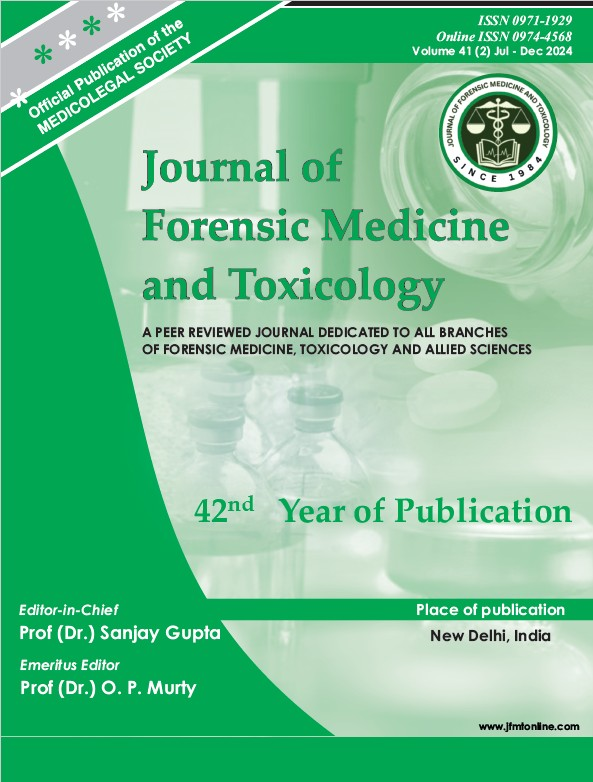A COMPREHENSIVE EXAMINATION OF POST-MORTEM SPERM RETRIEVAL TECHNIQUES– A REVIEW ARTICLE
Keywords:
Post Mortem Sperm Retrieval, Techniques, Assisted Reproduction, CryopreservationAbstract
Post-mortem sperm retrieval (PMSR) has emerged as a promising option for women desiring to conceive a child after the demise of their partner. This procedure involves the collection of sperm from deceased individuals, primarily males, to facilitate assisted reproductive techniques. The retrieval process, typically performed surgically or via electroejaculation, aims to obtain viable sperm shortly after death. Subsequently, the collected sperm can be cryopreserved for future use in in vitro fertilization (IVF) or intrauterine insemination (IUI). While PMSR presents an avenue for women to realize their dreams of parenthood with their departed partners, it is essential to recognize the ethical complexities and legal variations surrounding its application. Consent and the rights of the deceased are crucial considerations in this emotionally charged domain. Furthermore, the optimal retrieval technique remains elusive, hindering the successful procurement of an adequate sperm sample. In this comprehensive review, we present an overview analysis of various techniques involved in post-mortem sperm retrieval, as well as an examination of current techniques employed for retrieval and preservation.
Downloads
References
Widow of Alex “Chumpy” Pullin opens up about “incredible” sperm retrieval process [Internet]. [cited 2023 Aug 22]. Available from: https:// honey.nine.com.au/parenting/birth-stories-widow-of chumpy-pullin-postmortem-sperm-retrieval-ivf/ f594b27c-0523-400a-9db3-26854c831314.
Parents win right to use dead son’s sperm so they can have grandchild [Internet]. [cited 2023 Aug 22]. Available from: https://www.independent.co.uk/news/ world/americas/peter-zhu-death-frozen-sperm parents-grandchild-surrogate-mother-a8924641.html.
Kerr SM, Caplan A, Polin G, Smugar S, O’Neill K, Urowitz S. Postmortem sperm procurement. J Urol. 1997;157(6):2154-8.
Hurwitz JM, Batzer FR. Posthumous sperm procurement: demand and concerns. Obstet Gynecol Surv. 2004; 59:806–808.
Morgan LW, Morgan HG. The Legal and Medical Ethics of Post Mortem Sperm Retrieval on Behalf of Grandparents. Ethics of Post-Mortem Sperm Retrieval.2020;33:66-98.
Bureau AN. Delhi: Widow asks AIIMS doctors for dead husband’s sperm [Internet]. news.abplive.com. 2016.[Cited 2023 Aug 22]. Available from: https:// news.abplive.com/lifestyle/delhi-widow-asks-aiims doctors-for-dead-husbands-sperm-378961.
Bardale RV, Dixit PG. Birth after death: Questions about posthumous sperm retrieval. Indian J Med Ethics 2006; 3:122 3
Raziel A, Friedler S, Strassburger D, Kaufman S, Umansky A, Ron-El R. Using sperm posthumously: National guidelines versus practice. Fertil Steril. 2010 Aug;94(3):1154–6.
Land S, Ross LS. Posthumous reproduction: current and future status. Urol Clin North Am. 2002 Nov;29(4):863-71.
Tash JA, Applegarth LD, Kerr SM, Fins JJ, Rosenwaks Z, Schlegel PN. Postmortem sperm retrieval: The effect of instituting guidelines. J Urol. 2003;170(5):1922–5.
Shefi S, Raviv G, Eisenberg ML, Weissenberg R, Jalalian L, Levron J, Band G, Turek PJ, Madgar I. Posthumous sperm retrieval: analysis of time interval to harvest sperm. Hum Reprod. 2006 ;21(11):2890-3.
Jequier AM, Zhang M. Practical problems in the posthumous retrieval of sperm. Hum Reprod. 2014 ; 29(12):2615–9.
Horne HW, Paull DP, Munro D. Fertility studies in the human male with traumatic injuries of the spinal cord and cauda equina. N Engl J Med. 1948;16;239(25):959-61.
Ohl DA, Park J, Cohen C, Goodman K, Menge AC. Procreation after death or mental incompetence: Medical advance or technology gone awry? Fertil Steril. 1996;66(6):889–95.
Tash JA, Applegarth LD, Kerr SM, Fins JJ, Rosenwaks Z, Schlegel PN. Postmortem sperm retrieval: The effect of instituting guidelines. J Urol. 2003;170(5):1922–5.
Lorenzini F, Zanchet E, Paul GM, Beck RT, Lorenzini MS, Böhme E. Spermatozoa retrieval for cryopreservation after death. International Braz J Urol. 2018 Jan 1;44(1):188–91.
Robaire B, Hinton BT, Orgebin-Crist MC. Historical Perspective, 1072 Regulation of Epididymal Functions, 1092 Hormones, 1092 Testicular Factors, 1093 Major Protein Families in the Epididymis and Their Regulation, 1095 General Principles [Internet]. 1072. Available from: www.medicine.mcgill.ca/ PhysiolReprodThirdEd/
Dostal J, Utrata R, Loyka S, Brezinova J, Svobodova M, Shenfield F. Post-mortem sperm retrieval in new European Union countries: Case report. Hum Reprod. 2005; 20(8):2359–61.
Shah R. Surgical sperm retrieval: Techniques and their indications. Indian J Urol. 2011; 27(1):102-9.
Check M, Summers-Chase D, Check JH, Choe J, Nazari A. Sperm extracted and cryopreserved from testes several hours after death results in pregnancy following frozen embryo transfer: case report. Arch Androl. 1999; 43(3):235-7.
Jequier AM, Zhang M. Practical problems in the posthumous retrieval of sperm. Hum Reprod. 2014; 29(12):2615–9.
Ozkavukcu S, Erdemli E, Isik A, Oztuna D, Karahuseyinoglu S. Effects of cryopreservation on sperm parameters and ultrastructural morphology of human spermatozoa. J Assist Reprod Genet. 2008;25(8):403–11.
Turri F, Madeddu M, Gliozzi TM, Gandini G, Pizzi F. Effect of testicle postmortem storage on goat frozen thawed epididymal sperm quality as a tool to improve gene banking in local breeds. Animal. 2014 Mar;8(3):440–7.
Tumram NK, Bardale R V., Ambade VN. Sperm motility and viability extracted from penile tract of corpses: A preliminary study. Med Leg J. 2016; 84(3):132–4.
Nallella KP, Sharma RK, Allamaneni SS, Aziz N, Agarwal A. Cryopreservation of human spermatozoa: comparison of two cryopreservation methods and three cryoprotectants. Fertil Steril. 2004;82(4):913-8.
Gupta S, Sharma R and Agarwal A (2018). The process of sperm cryopreservation, thawing and washing techniques. Majzoub A and Agarwal A (eds),The Complete Guide to Male Fertility Preservation, pp. 183– 204. Berlin: Springer.
Robson SJ, Campbell S, McDonald J, Tremellen K, Carlin E, Maybury G. Pregnancy and childhood health and developmental outcomes with the use of posthumous human sperm. Hum Reprod. 2015; 30(10):2259-62.
Bergstein-Galan TG, Weiss RR, Barbosa TSR, Kozicki LE, Bicudo SD. Viability of ovine spermatozoa collected from epididymides stored at 18°-25°C for 48 hours post mortem. Arq Bras Med Vet Zootec. 2018 1;70(4):1023–8.




